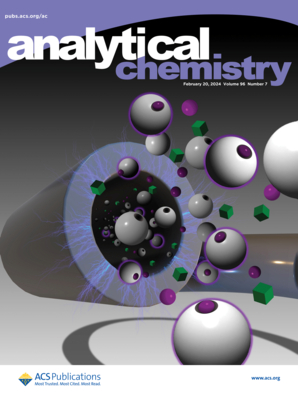Early Stage Soft Protein Corona Identification on Nanoparticles via Extended Size Exclusion Chromatography.
IF 6.7
1区 化学
Q1 CHEMISTRY, ANALYTICAL
引用次数: 0
Abstract
Unlike the hard protein corona (HPC), the soft protein corona (SPC) is a dynamic and complex layer for which limited knowledge exists regarding its structure and composition, primarily due to critical challenges in separating and purifying SPC from nanoparticles (NPs). In this study, we report the identification of SPC on the surface of polystyrene NPs at low time scales (i.e., a few to a hundred seconds). Using extended size exclusion chromatography (SEC) columns (i.e., 200 mm) and relatively large NPs (i.e., 300 nm), we successfully separated SPC-coated NPs from excess plasma. Our results show that SPC-coated NPs elute in early fractions, while excess plasma elutes in later fractions due to the significant size difference between plasma proteins and NPs, as well as the long column length. Additionally, SPC-coated NPs exhibit a relatively thicker shell compared with HPC-coated NPs, likely due to the rapid adsorption of large, abundant proteins such as albumin, as confirmed by both TEM and DLS measurements. Liquid chromatography-mass spectrometry (LC-MS) analysis further revealed that SPC formed at early incubation times (5-120 s) exhibited significantly lower protein diversity (59-93 proteins) compared to the hard protein corona (HPC, 152 proteins). The SPC composition dynamically evolved within seconds, highlighting the rapid competitive adsorption and displacement of abundant plasma proteins at nanoparticle interfaces in the first few seconds. These findings underscore the critical need for time-resolved approaches to accurately characterize nanoparticle-protein interactions at biologically relevant time scales.扩展尺寸排除色谱法鉴定纳米颗粒上的早期软蛋白冠。
与硬蛋白电晕(HPC)不同,软蛋白电晕(SPC)是一个动态和复杂的层,关于其结构和组成的知识有限,主要是由于从纳米颗粒(NPs)中分离和纯化SPC的关键挑战。在本研究中,我们报道了在低时间尺度(即几到一百秒)下聚苯乙烯NPs表面SPC的鉴定。使用扩展尺寸排除色谱(SEC)柱(即200 mm)和相对较大的NPs(即300 nm),我们成功地将spc包被的NPs从多余的等离子体中分离出来。我们的研究结果表明,由于血浆蛋白和NPs之间的显着大小差异以及柱长,spc包被的NPs在早期部分被洗脱,而在后期部分被多余的血浆洗脱。此外,与hpc包被的NPs相比,spc包被的NPs表现出相对更厚的外壳,这可能是由于快速吸附大量蛋白质(如白蛋白),TEM和DLS测量证实了这一点。液相色谱-质谱(LC-MS)分析进一步表明,在早期孵育时间(5-120 s)形成的SPC与硬蛋白冠(HPC, 152蛋白)相比,其蛋白质多样性(59-93蛋白)显著降低。SPC组成在几秒钟内动态演变,突出了在最初几秒钟内大量血浆蛋白在纳米颗粒界面上的快速竞争性吸附和位移。这些发现强调了对时间分辨方法的迫切需要,以便在生物学相关的时间尺度上准确表征纳米颗粒-蛋白质相互作用。
本文章由计算机程序翻译,如有差异,请以英文原文为准。
求助全文
约1分钟内获得全文
求助全文
来源期刊

Analytical Chemistry
化学-分析化学
CiteScore
12.10
自引率
12.20%
发文量
1949
审稿时长
1.4 months
期刊介绍:
Analytical Chemistry, a peer-reviewed research journal, focuses on disseminating new and original knowledge across all branches of analytical chemistry. Fundamental articles may explore general principles of chemical measurement science and need not directly address existing or potential analytical methodology. They can be entirely theoretical or report experimental results. Contributions may cover various phases of analytical operations, including sampling, bioanalysis, electrochemistry, mass spectrometry, microscale and nanoscale systems, environmental analysis, separations, spectroscopy, chemical reactions and selectivity, instrumentation, imaging, surface analysis, and data processing. Papers discussing known analytical methods should present a significant, original application of the method, a notable improvement, or results on an important analyte.
 求助内容:
求助内容: 应助结果提醒方式:
应助结果提醒方式:


